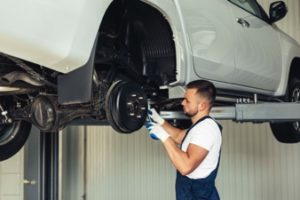What? We’re still not done?
The reality is that inspecting your vehicle never ends – until your trip is over and the ignition is off. Even then, if you hit a pothole during your trip or something flew off another vehicle and hit you while you were moving, you need to check for damage. But while you’re driving, you must always be aware of how things are working. Again, this is much easier when you operate one specific vehicle on a regular basis. As you drive, consider this:
- Does anything sound different from how it normally does?
- When you depress the brake pedal does the vehicle slow down right away? Does the pedal feel squishy or even go down to the floor? It’s always a good idea to test your brakes just after you start moving and are traveling slowly.
- Do your dashboard instruments appear to be reading the way they should? Is the temp gauge in its normal position? How about the RPMs? Do you know what RPMs means?
- Does the vehicle pull to one side or the other as you drive in a straight line?
- Are there any rattles or creaks that you did not hear yesterday?
- Did any dashboard light come on while you were driving?
- Is there anything at all that just feels different in any way?

The more in tune you are with your vehicle, the earlier you are likely to recognize a problem. The earlier you recognize issues with your vehicle, the more time you have to deal with them or prevent them from getting worse. Let’s face it, if you keep putting off having that worn tire replaced, what happens if it blows out at 60 miles per hour? Letting your worn brakes go for too long can lead to a very costly replacement – that’s if you don’t rear end another vehicle because you could not stop. All of this translates to bigger costs for you and time that your car is unavailable because it’s in the shop. As a safe, responsible driver, appreciate the importance of maintaining a vehicle that always operates up to standards.
Speaking of standards, many of the parts you just read about must, according to most state laws including Alabama, be fully operational. If they are not, you can be stopped and may receive a moving violation. If you take a second to think about it, you may be able to identify the most critical parts and systems in your vehicle that should be working properly whenever you drive:

- Your headlights must be operational – both of them.
- Your windshield must be free from cracks that might obstruct your vision.
- Your directionals and flashers must work.
- You must have working brakes, both regular and emergency.
- Your license plate(s) must be securely attached and any registration/inspection stickers must be affixed to the vehicle and up to date.
- You must have a rear view mirror attached to your windshield.
- Your rear window should not be obstructed.
- There should be no loose pieces hanging from the outside/undercarriage of your vehicle.
- Your brake/tail lights should work. Lenses should be intact.
- You must have a working horn in the vehicle. Use it only as a warning by giving a brief tap as you approach pedestrians, cyclists, or other drivers who may not be paying attention. Also be aware that you can be arrested for using your horn inappropriately, such as to “say hello” to your friends across the street.
- Your muffler and exhaust system must be intact and not emitting loud noises due to leaks. Leaks in an exhaust system don’t just cause loud noises. They emit the deadly carbon monoxide, CO. This odorless gas can seep into your vehicle and render you helpless before you even know it. Fix exhaust system leaks as soon as you detect them!

Here is one last important point. Of all the equipment and systems you just read about, do you know where they are? Can you identify or even operate them? Safe drivers know that you never just get into a vehicle, especially one that is new to you, and then drive away. Sure, headlights and windshield wipers all have the same functions. But that does not mean you turn them on and off the same way in every vehicle you operate. Don’t wait until it’s dark and you are traveling at 45 miles per hour to figure out how to activate the headlights. Don’t fumble around with switches after it begins to pour so you can turn on the wipers. There may be times when you borrow a car or must get a rental. Never get into a strange vehicle and just start it up and drive. It is critical to your safety that you familiarize yourself with the basic controls. You’ll need to know more than just how to find the steering wheel, the gas pedal, and the brakes. Find the controls for wipers and lights. Learn how to adjust seat positions and mirrors. Only then will you be ready for take off!
